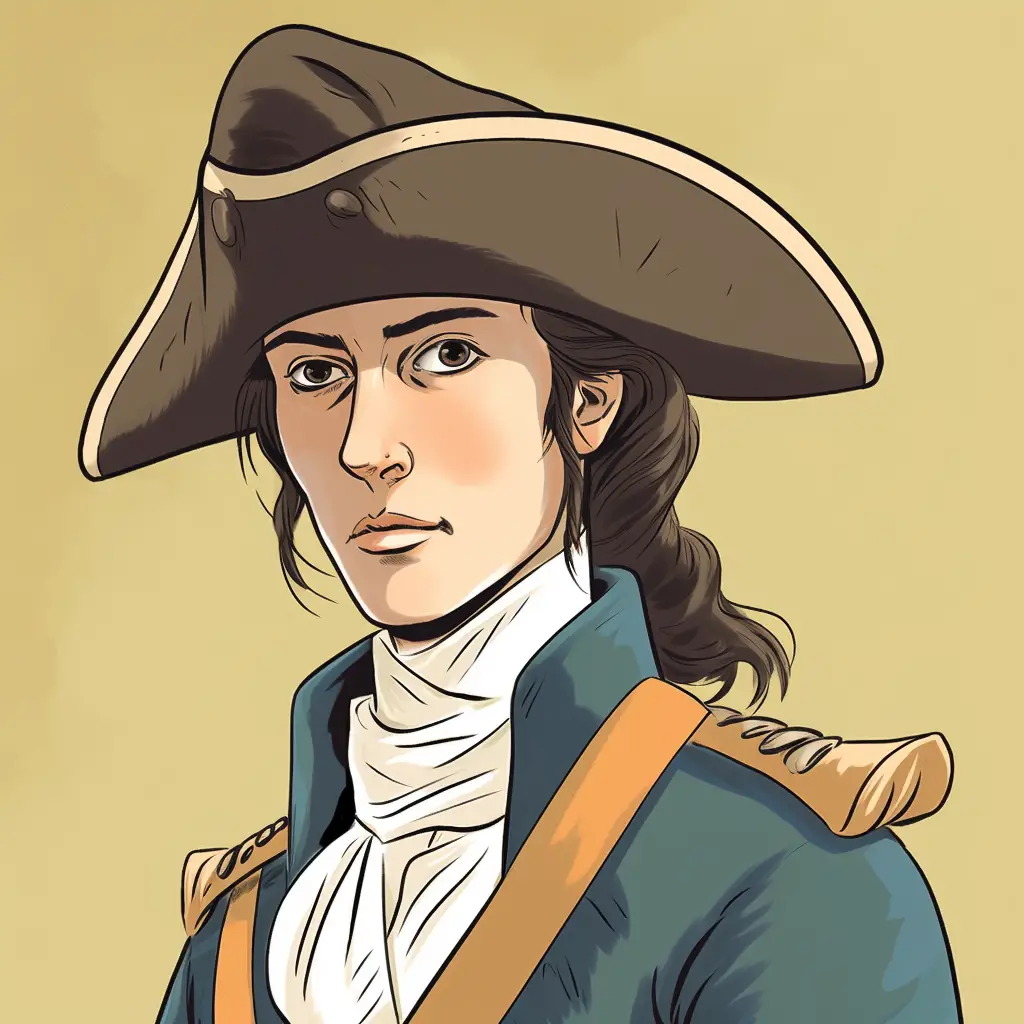Deborah Sampson
Deborah Sampson is one of the American Revolution heroes. It is a rare story in which Deborah disguised herself as a male to join the forces fighting the British.
She was the only woman to earn a full military pension for her Revolutionary army participation.
Deborah had a difficult upbringing. She was one of seven children of Jonathan Sampson, Jr. and Deborah (Bradford) Sampson.
Each side of the family held claim to being descendants of the Pilgrim founders. Jonathan was descended from Myles Standish and Priscilla Alden, and his wife was the great-granddaughter of Governor William Bradford.

Deborah Sampson Facts for Kids
- Deborah Sampson was born in Massachusetts, 1760.
- She disguised herself as a man to join the army.
- Sampson served in the Revolutionary War.
- Her pseudonym was “Robert Shurtliff.”
- She was wounded in battle but wasn’t discovered.
- Sampson was honorably discharged in 1783.
- She became a speaker, sharing her war stories.
Deborahs Early Years
Even with such a superb heritage, the Sampson family was always struggling. Jonathan set out to see, and when he didn’t come home, his wife had to put all seven children in different homes.
Deborah was only ten years old when she was bound as an indentured servant to a farmer in the area who had a large family that needed help. Once Deborah was 18, she completed her indenture and succeeded in being self-educated.
In 1779 and 1780, Deborah worked as a teacher during the summer months and in the winter as a weaver.
The American Revolutionary War
The Revolutionary War changed life for everyone, and in 1782 Deborah decided to show her patriotism by disguising herself as a man. She took on the name of Robert Shurtleff and joined the Fourth Massachusetts Regiment.
Assigned to Captain George Webb’s Company of Light Infantry in West Point, NY, Deborah was assigned a very dangerous job of being a scout on the neutral territory to get an idea of the number of British in Manhattan where General Washington was thinking of attacking.
Deborah faced real danger when, in 1782, she and two sergeants led an expedition of thirty infantrymen that led to a confrontation with the British Tories. The fights were often face-to-face.
Deborah headed another expedition for a raid on the home of a Tory whose success ended up in the capture of 15 men. Deborah dug trenches during the siege of Yorktown as well as faced cannon fire and assisted in storming the British.
Deborah hid her identity for more than two years. There had been a few close calls, but she took control so that she wasn’t discovered. When Deborah was shot in her left thigh, she removed the pistol ball on her own.
Continental Army
Deborah Sampson, a notable figure of the American Revolutionary War, enlisted in the Continental Army under the alias Robert Shurtleff. In a time when women were restricted from combat roles, Sampson defied norms by serving in the 4th Massachusetts Regiment.
Her service was marked by courage and resilience, even as she maintained her male disguise to hide her gender, despite injuries. Her commitment underscores the diverse contributions to the Continental Army’s efforts in the war.
Robert Shurtleff

Robert Shurtleff was the alias of Deborah Sampson during the American Revolutionary War. To circumvent societal norms limiting women’s roles, particularly in the military, Sampson enlisted in the 4th Massachusetts Regiment of the Continental Army as Shurtleff.
Despite sustaining injuries, she served in several combat roles with remarkable courage, significantly contributing to the war efforts. Thus, the story of Shurtleff symbolizes Sampson’s daring commitment to American independence.
Women in the Military
Deborah Sampson’s story exemplifies the unrecognized involvement of women in the military during the American Revolutionary War. She disguised herself as a man, Robert Shurtleff, to enlist in the Continental Army and participated in active combat, defying societal norms of the time.
Even when injured, she remained disguised, underscoring her resilience and dedication. Sampson’s actions challenge traditional narratives of military service and inspire future generations.
Molly Pitcher
Molly Pitcher and Deborah Sampson are renowned figures of women’s involvement in the American Revolutionary War. Sampson served in the Continental Army under the alias Robert Shurtleff, while Pitcher is celebrated for aiding soldiers by carrying water to the battlefield.
Despite their distinct roles, both women defied societal norms, exemplifying bravery and resilience. Their contributions underscore the diversity of women’s roles during the Revolutionary War.
Massachusetts
Deborah Sampson’s story is deeply rooted in Massachusetts, her birthplace and where she joined the Continental Army. Disguising herself as Robert Shurtleff, she served in the 4th Massachusetts Regiment, contributing significantly to the American Revolutionary War.
Sampson’s legacy, a distinct chapter in Massachusetts’s history, continues to be commemorated today.”
Illness and Discharge
It wasn’t until Deborah became ill in Philadelphia during an epidemic and lost consciousness and was taken to a hospital that her gender was discovered
On October 23, 1783, she received an honorable discharge and came home to Massachusetts.
Marriage
She married Benjamin Gannet, and the couple had three children.
Deborah received a military pension from the state of Massachusetts.
While Deborah lived a lot of her life on the farm, she decided to begin a lecture tour in 1802 to tell her tale. She often dressed in full military uniform and was the first woman in America to ever do such a thing.
Deborah’s life was told in 1797 in the book “The Female Review: or, Memoirs of a Young American Lady” by Herman Mann.
Deborah died in Sharon, Massachusetts on April 29, 1827, at the age of 66, and four years later, her husband sent a Congressional petition for pay as a soldier’s spouse.
The conclusion of the committee was that no other similar example of female heroism, fidelity, and courage had ever been seen as Deborah’s, and he was awarded the money. Her husband died before he received it.
Fun Facts about Deborah Sampson
- Born: December 17, 1760, in Massachusetts
- Parents: Jonathan Sampson and Deborah Bradford
- Disguised herself as a man and enlisted during the American Revolution
- Was known as Private Robert Shurtliff during the American Revolution
- On October 23, 1783, she received an honorable discharge
- Married Benjamin Gannett and hard three children Earl (1786), Mary (1788), Patience (1790), and Susanna (adopted)
- The only woman to earn a full military pension for her Revolutionary army participation.
- Died: April 29, 1827, in Sharon, Massachusetts
What did you learn?
How did Deborah Sampson spend most of her early youth?
As an indentured servant
At what year did Deborah Sampson decide to disguise herself as a man and join the military?
1782
What did Deborah do when she was shot in the leg?
Removed the pistol ball herself
How was Deborah’s identity found out?
She fell ill and became unconscious and was taken to a hospital
What kind of military fighting was Deborah involved in?
Face to face combat
How did the state of Massachusetts honor Deborah for her service?
Gave her a military pension



